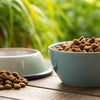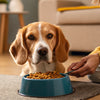What Is the Best Wet Dog Food for Weight Loss?
- Houndsy
Table of Contents
- Introduction
- Understanding Weight Management for Dogs
- What Makes the Best Wet Dog Food for Weight Loss?
- How to Transition Your Dog to Weight Loss Food
- Activity Levels and Weight Management
- Conclusion
- FAQs
Introduction
Did you know that nearly 60% of dogs in the United States are classified as overweight or obese? This staggering statistic should concern all of us as loving pet owners, as excess weight can lead to a myriad of health issues for our four-legged friends, from joint problems to chronic diseases. With the right diet and exercise plan, we can help our dogs shed those extra pounds and lead healthier, happier lives. But how do we go about finding the best wet dog food for weight loss?
In this blog post, we will explore the essential characteristics of quality wet dog food tailored for weight management, consideration when selecting dog food, and practical tips on making dietary changes for your canine companion. Our goal is to empower you to make informed choices that improve your pet's health and overall well-being.
By the end of this article, you'll not only understand the intricacies of selecting the best wet dog food for weight loss but also gain insights into the benefits of incorporating a convenient solution like the Houndsy Kibble Dispenser into your feeding routine. Let’s dive into our exploration of the best options for helping your dog maintain a healthy weight!
Understanding Weight Management for Dogs
The Importance of Weight Control
Weight management is essential for dogs of all breeds, life stages, and sizes. Common health issues associated with excess weight include:
- Joint Problems: Extra weight puts strain on the joints, leading to arthritis and discomfort.
- Diabetes: Being overweight increases the risk of insulin resistance and diabetes in dogs.
- Heart Disease: Extra body fat can lead to heart conditions over time.
- Decreased Lifespan: Studies have shown that maintaining a healthy weight can enhance a dog’s overall longevity and quality of life.
Conversely, achieving a healthy weight can reduce these risks, improve their energy levels, and promote a longer, happier life. Along with regular exercise, diet plays a pivotal role in weight management.
How Diet Affects Your Dog's Weight
Food provides the essential nutrients dogs need to thrive, but not all food is created equal, especially regarding caloric content, fiber, and protein levels. When selecting a diet aimed at weight loss, consider few key factors:
-
Caloric Density: Select foods with fewer calories per serving to ensure your dog can eat a satisfactory volume while still achieving weight loss.
-
High Fiber Content: Fiber helps dogs feel fuller for longer, reducing the urge to overeat while maintaining digestive health.
-
Lean Proteins: High-quality protein sources help maintain muscle mass during weight loss and support metabolism.
-
Life Stage Appropriateness: Different life stages necessitate different dietary considerations, from puppies to seniors. Choose food suited to your dog's age and health needs.
-
Quality Ingredients: Look for brands that ensure their dog food meets the standards set by the Association of American Feed Control Officials (AAFCO).
As we address these factors, let’s dive into what specifically qualifies as the best wet dog food for weight loss.
What Makes the Best Wet Dog Food for Weight Loss?
Key Ingredients to Look For
-
High Fiber: Foods boasting at least 5-10% fiber can help regulate your dog’s bowel movements and promote a sense of fullness. Ingredients like beet pulp and pumpkin are excellent sources.
-
Lean Proteins: Ingredients such as chicken, turkey, or fish should be the best options for protein sources. These should comprise the primary ingredients in wet food, ensuring your canine maintains muscle mass.
-
Low Caloric Content: The nutritional profile of high-quality wet dog food should be formulated to include fewer calories—generally, around 300-350 kcal per can. Look for caloric content that supports your pet's weight loss goals without compromising nutritional value.
-
Moisture Content: Current research suggests that wet food’s higher moisture content (around 75-78% water) can keep dogs hydrated, helping them feel full while reducing caloric intake.
-
Nutritional Completeness: Wet dog food that provides all necessary vitamins and minerals (such as vitamins E, A, and various B vitamins) is key to ensuring your dog’s nutritional needs are met during their weight loss journey.
Notable Brands of Wet Dog Food for Weight Loss
Here are some noteworthy picks recognized by veterinarians and nutrition experts for their efficacy and quality in promoting weight loss in dogs:
-
Purina Pro Plan Weight Management Turkey and Rice Entree: Tender chunks of turkey and rice make this formula palatable for dogs while being rich in essential nutrients. Each can contains around 263 kcal.
-
Royal Canin Weight Care: Offering a unique blend of protein and fiber, it contains fewer calories per serving while promoting digestive health.
-
Hill's Science Diet Perfect Weight: This brand emphasizes the importance of quality ingredients and nutritional science, providing balanced meals that assist with weight control and overall health.
-
Natural Balance Fat Dogs: This high-fiber wet food keeps your dog full while managing caloric intake.
-
Merrick Healthy Weight Real Chicken and Brown Rice: Whole food ingredients keep this dish flavorful, satisfying, and healthy for weight management.
As you consider these options, keep in mind that it's vital to consult your veterinarian for tailored recommendations based on your dog's unique needs.
How to Transition Your Dog to Weight Loss Food
Planning the Transition
Transitioning to a weight management diet should be gradual to help your dog adjust without digestive upset. Follow these steps:
-
Start Slow: Introduce the new food slowly by mixing a small amount with your dog's current diet. Gradually increase the ratio of the new food over 7-10 days.
-
Monitor Portions: Utilize measuring tools or a kitchen scale to ensure you're feeding the correct portion size, as incorrect portions can undermine weight loss efforts.
-
Regular Meal Times: Establish regular feeding schedules to promote routine and make it easier to manage caloric intake.
-
Always Provide Fresh Water: Keeping your dog hydrated is essential, and water helps them feel full.
The Role of the Houndsy Kibble Dispenser
Integrating the Houndsy Kibble Dispenser into your dog feeding routine can enhance your overall feeding strategy. This innovative product offers perfect portion control that eliminates the need for bending, making it easier for pet owners to dispense the right amount of food each time. With a sleek mid-century modern design, it seamlessly complements your home decor while promoting a hassle-free feeding experience.
Explore the various features of the Houndsy Kibble Dispenser on our product page to learn how it can simplify your feeding routine.
Activity Levels and Weight Management
The Importance of Exercise
Feeding your dog a calorie-controlled diet is only one part of effective weight management. Alongside the right food, exercise plays a crucial role. Aim for at least 60 minutes of exercise each day, which can be split into shorter sessions based on your dog's abilities and preferences.
-
Daily Walks: Simple daily walks can effectively combat obesity. Regular leash walks can help your dog burn calories and stimulate their minds.
-
Interactive Play: Games such as fetch, tug-of-war, and agility training not only keep your dog active but also strengthen your bond.
-
Engaging Toys: Investing in interactive toys that encourage exercise can keep your dog active indoors.
Regular check-ins with your vet to discuss weight management plans, food choices, and activity levels will ensure a tailored approach to your dog’s health.
Conclusion
Successfully managing your dog’s weight involves understanding the importance of dietary choices and incorporating healthy levels of exercise into their routines. By selecting high-quality wet dog food designed for weight loss, we can help our furry friends shed extra pounds while ensuring they receive the nutritional balance they need.
As you embark on this journey, consider how central feeding solutions like the Houndsy Kibble Dispenser can make the process easier and more enjoyable for both you and your dog. Let’s work towards a healthier, happier life for our beloved pets, ensuring their diet and exercise support their well-being.
FAQs
Q: What is the best thing to feed a dog to lose weight?
A: The best approach to weight loss should involve a high-quality, research-backed weight-control dog food that reduces calories without compromising nutrition. Foods high in fiber and lean protein will effectively support weight loss while maintaining energy levels.
Q: Is wet or dry dog food better for weight loss?
A: Wet food can be better for creating the sensation of fullness due to its moisture content, making it useful for weight management. However, every dog is different, and both wet and dry foods can facilitate healthy weight loss when combined with portion control and regular exercise.
Q: When should I start feeding my dog weight loss food?
A: You should consult with your veterinarian to define the best timeline for transitioning. Generally, it is advisable to introduce weight loss food gradually, starting once your vet assesses and advises that your dog is overweight.
Q: What other methods aid in my dog’s weight loss beyond diet?
A: Combining a balanced diet with regular exercise — such as daily walks, play sessions, and engaging activities — significantly enhances your dog's overall health and assists in weight management.
Ready to transform your dog’s feeding experience? Explore the features of our Houndsy Kibble Dispenser and elevate your pet care routine! Order Now.












